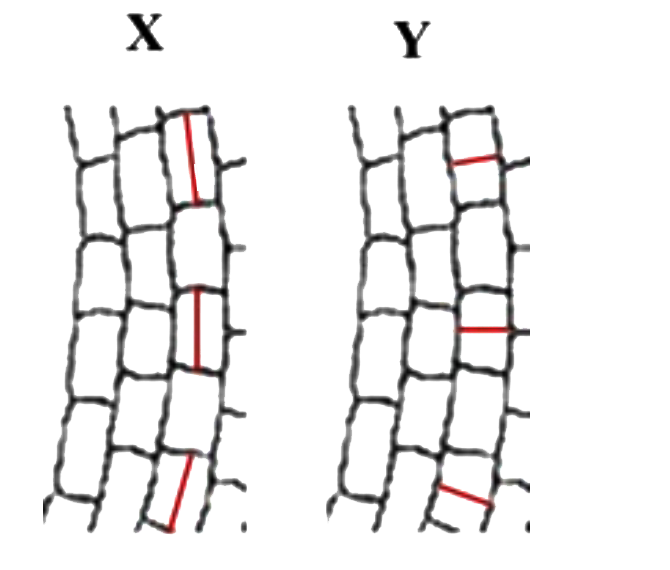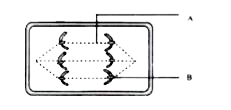A diploid living organism develops from zygote undergoes which type of repeated cell division?
meiosis
amitosis
mitosis
segmentation
The correct Answer is:C
To answer the question regarding the type of repeated cell division that a diploid living organism undergoes after developing from a zygote, we can follow these steps:
1. Understanding the Zygote:
- A zygote is the initial cell formed when a sperm cell fertilizes an egg cell. It is diploid, meaning it contains two sets of chromosomes, one from each parent.
Hint: Remember that a zygote is the first cell of a new organism and is diploid.
2. Cell Division Types:
- There are two main types of cell division: mitosis and meiosis.
- Mitosis is the process of cell division that results in two genetically identical daughter cells, maintaining the same chromosome number.
- Meiosis, on the other hand, is a reduction division that produces gametes (sperm and egg cells) with half the chromosome number (haploid).
Hint: Differentiate between mitosis (for growth and repair) and meiosis (for gamete formation).
3. Cell Division After Zygote Formation:
- After the zygote is formed, it undergoes a series of cell divisions to develop into a multicellular organism.
- Since the zygote is diploid, the type of cell division that will occur to produce more diploid cells is mitosis.
Hint: Focus on the fact that the organism needs to maintain its diploid state during development.
4. Cleavage Divisions:
- The initial divisions that occur after the zygote formation are called cleavage divisions, which are a series of rapid mitotic divisions that lead to the formation of a multicellular embryo.
Hint: Cleavage divisions are specifically mitotic and occur right after fertilization.
5. Conclusion:
- Therefore, the type of repeated cell division that a diploid living organism undergoes after developing from a zygote is mitosis.
Final Answer: The repeated cell division is mitosis.
Summary of the Solution:
After the formation of a diploid zygote, the organism undergoes repeated cell divisions known as mitosis, specifically during the cleavage stages of development.
- A zygote is the initial cell formed when a sperm cell fertilizes an egg cell. It is diploid, meaning it contains two sets of chromosomes, one from each parent.
- There are two main types of cell division: mitosis and meiosis.
- Mitosis is the process of cell division that results in two genetically identical daughter cells, maintaining the same chromosome number.
- Meiosis, on the other hand, is a reduction division that produces gametes (sperm and egg cells) with half the chromosome number (haploid).
- After the zygote is formed, it undergoes a series of cell divisions to develop into a multicellular organism.
- Since the zygote is diploid, the type of cell division that will occur to produce more diploid cells is mitosis.
- The initial divisions that occur after the zygote formation are called cleavage divisions, which are a series of rapid mitotic divisions that lead to the formation of a multicellular embryo.
- Therefore, the type of repeated cell division that a diploid living organism undergoes after developing from a zygote is mitosis.
After the formation of a diploid zygote, the organism undergoes repeated cell divisions known as mitosis, specifically during the cleavage stages of development.
Topper's Solved these Questions
- CELL CYCLE AND CELL DIVISION BOOK - ICSECHAPTER - CELL CYCLE AND CELL DIVISION EXERCISE - REVIEW QUESTIONS (WRITE TRUE T OR FALSE F)
5 Videos
- CELL CYCLE AND CELL DIVISION BOOK - ICSECHAPTER - CELL CYCLE AND CELL DIVISION EXERCISE - REVIEW QUESTIONS (ANALOGY TYPE QUESTIONS)
5 Videos
- CELL CYCLE AND CELL DIVISION BOOK - ICSECHAPTER - CELL CYCLE AND CELL DIVISION EXERCISE - NCERT EXERCISE WITH ANSWER (DIFFERENT BETWEEN )
4 Videos
- CELL : THE UNIT OF LIFE BOOK - ICSECHAPTER - CELL : THE UNIT OF LIFE EXERCISE - Differentiate Between
18 Videos
- CELLULAR RESPIRATION IN PLANTS BOOK - ICSECHAPTER - CELLULAR RESPIRATION IN PLANTS EXERCISE - REVIEW QUESTIONS ( LONG ANSWER TYPE QUESTIONS)
15 Videos
Similar Questions
Knowledge Check
Assertion : Embryogenesis is the development of embryo from the zygote.
Reason : Cell division increase the number of cells in the developing embryo.AIf both assertion and reason are true and reason is the correct explanation of assertion.BIf both assertion and reason are true but reason is not the correct explanation of assertion.CIf assertion is true but reason is false.DIf both assertion and reason are false.
Zygote of an organism developed after syngamy undergoes meiosis to form haploid spores, which divide mitotically and form the gametophyte. The organism must have ____ life cycle.
View SolutionWhich type of cell division is called somatic cell division ?
View SolutionDuring the formation of gametophytes and embryo in angiosperms, the cell undergo two types of cell divisions. The diagram given below is a representation of them. The red lines indicate their plane of division . What is the correct type of X and Y ?

View SolutionChoose the correct option fron following statements
I. During embryogenesis, zygate undergoes mitotic cell division.
II. In organisms with diplontic life cycle, zygote divides by meiotic cell division.
III. The pericarp (fruit wall) develop from integument of ovule, after fertillzation.
IV. In brinjal, sepals remained attached to fruit even after fertilization.
View SolutionThe smallest living cells/ organisms :
View SolutionTo determine the type of organic compounds found in living organism, the living tissue is ground with the help of a mortar and a pestle in
View SolutionThe diagram given below represents a certain stage of mitosis :

How many daughter cells are formed from this type of cell division?
View Solution
